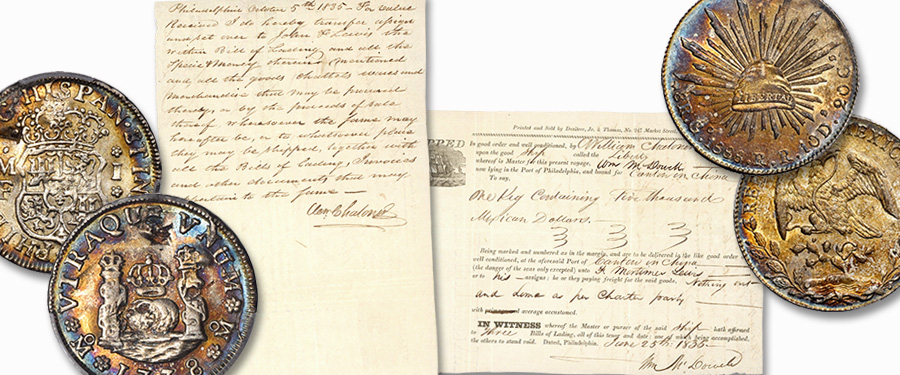
Our first Hong Kong Collectors Choice Online auction, set for November 30-December 3, 2021, focuses on a broad range of Asian numismatic items, as well as some interesting pieces that do not necessarily fit neatly into that category. One such item is a shipping invoice dated June 25, 1835, detailing the shipment and transfer of a keg of 5,000 Mexican 8 Reales from William Chaloner to John F. Lewis after shipment. The keg was placed upon the clipper ship Liberty, ported in Philadelphia, with a destination of Canton (modern day Guangzhou) in China. The reverse of the document contains a handwritten agreement signed in Philadelphia on October 5, 1835, ostensibly after the completion of the shipment, granting the cargo of the ship to Lewis from Chaloner in return for Specie Money.
This kind of transaction was common in the first half of the 19th century in the West, with a shipment of goods being contracted for a final delivery to the other side of the world. The date of 1835 slightly predates the apex of the clipper ship era, where these fast moving light ships were the primary trade vessels for long journeys. Clipper ships sailing around Cape Horn were the fastest way for goods to reach East Asia from Eastern North America. From 1757 until 1842, all trade into China from the West had to arrive through the port of Canton to avoid encroachment from Imperial powers. China (along with Japan at the time) was very skeptical of trade with the West, seeing the effects of European colonization in the New World. Despite the many goods that China had to offer Western markets, there was very little that the traditional European powers or the new nations of the United States and Mexico had to offer in return. One exception was silver specie that China valued as money. A consequence was that wealthy Western merchants would import silver coinage from many nations into China to facilitate commerce, as this invoice details. The value that China placed on silver as a commodity can be seen in later issues of Trade Dollars struck specifically for export to China by the United States, the British Empire, and Japan.
This system of import into Canton only lasted a few years beyond the date of this invoice, as in 1839 the British, ever looking to expand maritime influence, launched the first of the Opium Wars and China had to make concessions, opening more ports to Western trade. In 1853, Japan was forced to open to the wider world when Commodore Matthew Perry threatened gunboat diplomacy against that nation. In the second half of the 19th century, East Asia would be more deeply tied to the West than during the first half.
In addition to the shipping invoice, the December Hong Kong Collectors Choice Auction features several examples of the fractional Mexican Reales type described, along with later Cap and Rays issues. These include chopmarked and unchopped examples. Interestingly, these Mexican 8 Reales would have been legal tender in both Philadelphia and Canton, as foreign currency freely circulated in the United States along with American coins until the Coinage Act of 1857 banned the practice. The Mexican 8 Reales and this invoice illustrate the growing influence of the Western world upon the Eastern one.
To view our upcoming auction schedule and future offerings, please visit StacksBowers.com where you may register and participate in this and other forthcoming sales.
We are always seeking coins, medals and paper money for our future auctions, and are currently accepting submissions for our January 2022 Official Auction of the NYINC next January and our Spring 2022 Hong Kong auction. Additionally, we are accepting submissions for our Collectors Choice Online (CCO) auctions, the next of which will be in February. If you would like to learn more about consigning, whether a singular item or an entire collection, please contact one of our consignment directors or info@stacksbowers.com today and we will assist you in achieving the best possible return on your material.





